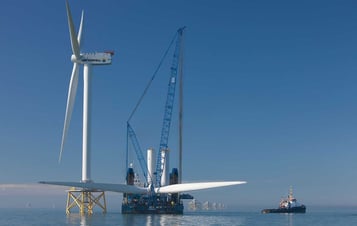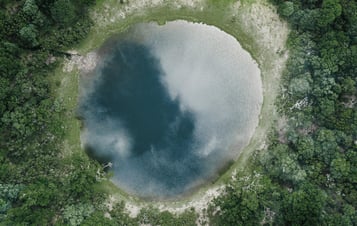Glossary
A B C D E F G H I J K L M N O P Q R S T U V W X Y Z
Power units
Energy units
Weight units
Voltage
A
Ancillary services: Are purchased by the Transmission System Operator in order to ensure a balanced and reliable electric power system and can be provided from power plants, assets with flexible electricity consumption, or energy storage. There are different types of ancillary services where the requirement on endurance and speed differ.
Availability: Refers to technical availability, which is the percentage of planned production time for an asset without unexpected technical difficulties or maintenance needs.
B
Bankable: Refers to something that is deemed acceptable or suitable for financial support from e.g. institutional investors or approval from a bank or financial institution.
Biomass: Renewable fuel, such as forest residues, bark and pine oil.
C
Carbon capture, utilisation and storage, (CCUS): A process that involves the capture of CO2 from sources, such as fossil fuel -powered power generation or industrial facilities. The CO2 can also be captured directly from the atmosphere. If not being used on-site, the captured CO2 is compressed and transported by pipeline, ship, rail or truck to be used in a range of applications, or injected into deep geological formations for permanent storage. CCUS using biomass as a fuel is called bio-CCUS.
Circular economy: A circular economy is a framework for sustainable growth – with the overarching goal to reduce society’s resource use and the resulting environmental impact.
Co-location/Co-use: The act of placing or using two or more facilities, activities or assets in a single location. For example, agrivoltaic is the combination of sustainable agriculture and solar power generation on the same agricultural land.
Combined heat and power, (CHP): A plant that produces both heat and electricity. In such a plant a large share of the primary energy is used for electricity and heat production, with little wasted heat.
Corporate Power Purchase Agreement, (cPPA): A Corporate Power Purchase Agreement is usually a long term agreement between a renewable energy generator and a corporate customer or an organisation.
D
Decentralised production/energy solutions: Any form of energy provision that is not provided from the central electricity grid, for example local power generation such as rooftop solar panels, heating solutions including heat pumps and storage technologies.
Derivative instrument: A derivative is a financial instrument that is commonly used to manage risk. The value and change in value of derivative instruments are derived from the value of an underlying asset, which can be commodities, precious metals, currency, bonds, stocks and similar. Examples of derivative instruments are options, forward contracts and swaps.
Develop-to-sell: Refers to projects that are developed to be sold at completion as opposed to projects that are being built to own.
Dispatchable electricity source: Sources of electricity that can be readily turned on and off and used to adjust the supply of power to the grid on demand.
E
Efficiency: An efficiency rating indicates the relationship between energy input and energy output in a system.
Electrofuel: Electrofuel is categorised as a sustainable aviation fuel since the only inputs to the process of making electrofuel are fossil-free electricity, water and recycled carbon dioxide (in contrast to virgin fossil feedstock). Electricity will be mainly used to make hydrogen via electrolysis which together with carbon dioxide can be converted into ethanol and next converted to aviation electrofuel.
Environmental Product Declaration, (EPD): A third-party environmental declaration in accordance with ISO 14025 (see www.environdec.com).
The EU Emissions Trading System, (EU ETS): The EU's trading system for CO2 emission allowances. The system sets a cap for emissions from businesses within the system and facilitates optimisation through trading in emission allowances.
F
Forced labour: All work or service which is exacted from any person under the menace of any penalty and for which the said person has not offered himself voluntarily.
Forward market: A market in which buyers and sellers agree on a set price for a future delivery of the underlying instrument, such as an electricity contract (see also derivative instrument).
Fossil fuels: Fuels based on hydrocarbons from ancient sedimentary layers – mainly coal, oil and natural gas.
G
Global Compact: The United Nations' (UN's) ten principles for companies surrounding human rights, labour issues, the environment and anti-corruption.
Global Reporting Initiative, (GRI): A global standard for sustainability reporting (see www.globalreporting.org).
Guarantee of origin: Guarantees certify how and where electricity was produced from renewable sources.
H
Heat only boiler, (HOB): A plant that produces heat for district heating as its sole output.
High-risk minerals: Minerals that are mined in an area of armed conflict and traded illicitly to finance the conflict; deemed essential to the energy transition which may have no viable substitutes, and may face potential disruption in supply; or considered rare earth elements (REE).
Hydrogen: Hydrogen as a fuel source can be produced in several different ways and is typically categorised into different colours depending on the production process. Grey hydrogen is currently the most common form of hydrogen production where the hydrogen is created from natural gas using steam reforming. Blue hydrogen is also extracted using the steam reforming process, but the carbon emissions released from the production process are captured and stored. Green hydrogen doesn’t generate any emissions in its entire life cycle as it is produced by electrolysing water using renewable energy.
I
Installed capacity: Also known as nameplate capacity. Refers to the maximum amount of electricity that a power plant can produce under specific conditions according to the design data. Commonly measured in MW (Megawatt).
International Financial Reporting Standards, (IFRS): Vattenfall has been reporting in accordance with IFRS since 2005.
ISO 14001: An international standard in the ISO 14000 series for establishing environmental management systems.
J
Just Transition and Responsible Decommissioning: A process involving employers, unions, governments and communities, planning and delivering the transition of economies, sectors, and companies to low carbon, socially just and environmentally sustainable activities. At the company level, a just transition is process that plans emissions reduction efforts to maximise positive impacts and minimise negative impacts on workers and communities through retention and redeployment, skills training, new job creation, social inclusion and community renewal.
L
Levelised Energy Cost, (LEC): The average cost of production per kilowatt hour electricity, calculated over the full lifetime of the generating asset. The net present value method is used to discount future costs with the weighted average cost of capital (WACC).
Life cycle analysis, (LCA): Methodology to establish a product's total environmental impact during its life cycle, from raw material extraction, through manufacturing processes and usage, to waste management, including all transportation and energy consumption.
Lost Time Injury, (LTI): Work-related accidents resulting in absence longer than one day, and accidents resulting in fatality. Commonly expressed as LTIF, or Lost Time Injury Frequency, the number of such accidents per 1 million hours worked.
M
Margin call: Margin is collateral and funds that are collected to protect against future or current risk exposures resulting from market price changes or in the event of a counterparty default. A margin call occurs when the price of the underlying asset changes.
N
Net Promoter Score, (NPS): NPS is a score ranging from –100 to 100 that measures the willingness of customers to recommend a company’s products or services to others and is used to determine customers' overall satisfaction with a company and loyalty to the brand.
Nord Pool: The Nordic electricity exchange. Started in Sweden and Norway in 1996.
NOX: Collective term for nitrogen oxide, nitrogen dioxide and similar nitrogen compounds.
O
Offtaker: An offtaker is a party that, in advance, agrees to buy or sell goods that are still to be produced. In the energy market, this typically refers to the party that buys electricity through a PPA (see below).
Over the Counter, (OTC): Trading outside of exchanges (directly or via brokers) in physical and financial contracts.
P
Particulate Matter: Particulate matter consists of a mixture of solids and liquid droplets. Some particulate matter is emitted directly, otherwise it forms when pollutants emitted by various sources react in the atmosphere. Particulate matter comes in different sizes, with that smaller than 10 micrometers able to enter our lungs and cause serious health problems.
Plannable production: See Dispatchable electricity source.
Power-as-a-service, (PaaS): A business model which provides major energy users with guaranteed power services in exchange for a fixed monthly fee.
Power-to-Heat: Converting electricity to heat using electric boilers combined with hot water storage. With Power-to-Heat systems, the excess power generated primarily from renewable energy can be utilised later as district heating.
Power-to-X: An umbrella term referring to the conversion of electricity to an energy carrier, heat, product or raw material. Power-to-X includes e.g. power-to-gas, power-to-liquid, power-to-chemicals and power-to-heat. More specific examples are production of hydrogen, methane, ammonia, methanol, jet fuel, diesel etc. using electricity as the primary energy source.
Price areas: The Nordic electricity system is split into 15 price areas (or bidding areas) and generated electricity is always priced in the area where it is geographically located.
Primary energy: Primary energy is the form of energy that is accessible directly from the original sources. Vattenfall uses the interpretation applied by Eurostat and IEA. This means that all fuels are assigned a primary energy content corresponding to their heating value. Uranium is assigned a primary energy content corresponding to the heat released in the power plant. Solar, wind and hydro power are assigned a primary energy content corresponding to the extracted electricity (or heat).
Psychological safety: An environment where there is a shared expectation that one will not be embarrassed, rejected, or punished for sharing ideas, taking risks, or soliciting feedback.
R
Renewable energy sources: Non-finite energy sources such as hydro power, biomass, wind, the sun, ocean waves and geothermal energy.
Reservoir levels: Refers to the volume of water stored in a reservoir which on a specific occasion can be used for hydro power generation. Reservoir levels vary during the year depending on precipitation and hydro power generation.
S
SF6: A greenhouse gas commonly used for electrical insulation that is 15,000 times more potent than CO2.
Small modular rector, (SMR): A type of nuclear reactors that are smaller and more flexible than conventional reactors, typically with an electrical power output of up to 300 MW per unit. Due to a modular and standardised design, components of SMRs can be pre-manufactured in a factory, then assembled, commissioned and operated at a separate site.
Smart meter: Smart meters replace existing gas and electricity meters and is usually an electronic device that records information such as consumption of electric energy, voltage levels, current, and power factor of an installation or building. They also have the ability to send and store meter readings automatically and at regular intervals over the internet.
SOx: Collective term for sulphur oxides, sulphur dioxide and similar sulphur compounds.
Spot market: A market in which trading is conducted for immediate delivery.
Svensk Kärnbränslehantering AB, (SKB): The Swedish Nuclear Fuel Management Company, responsible for handling radioactive waste in Sweden.
Swap: A financial instrument that is a combination of a spot and forward transaction – a type of financial swap agreement.
System Average Interruption Duration Index, (SAIDI): An index of average power interruption times within electricity distribution. Measured in terms of interruption duration per customer and year.
System Average Interruption Frequency Index, (SAIFI): An index of average power interruption frequency within electricity distribution. Measured in terms of the number of power interruptions per customer and year.
T
Thermal power: Electricity generated via a heating process, such as a gas turbine or a steam process in a coal or nuclear power plant (compare combined heat and power).
Third Party Integration, (TPI): A process in which excess or waste heat, which would otherwise be released to the atmosphere, is captured from the industrial facilities in which it is produced and integrated into the district heating network.
V
Value chain: All activities, operations, business relationships and investment chains of an undertaking and includes entities with which the company has a direct or indirect business relationship, upstream and downstream.
Volatility: A measure of how the price of a product varies during a given period of time.
W
Whistleblowing: A procedure that is voluntarily implemented by Vattenfall and which allows employees, contractors, suppliers, partners and other external and internal stakeholders to report serious irregularities and other complaints at Vattenfall.
Power units
- Power is energy per unit of time
- Power output is measured in watts (W)
- 1 kW (kilowatt) = 1,000 W
- 1 MW (megawatt) = 1,000 kW
- 1 GW (gigawatt) = 1,000,000 kW
Energy units
- Energy is power multiplied by time
- 1 kWh (kilowatt hour) = 1 kW in one hour
- 1 MWh (megawatt hour) = 1,000 kWh
- 1 GWh (gigawatt hour) = 1,000,000 kWh
- 1 TWh (terawatt hour) = 1,000,000,000 kWh
Weight units
- ktonnes (kilotonnes) = 1,000 tonnes
- Mt or Mtonnes (megatonnes) = 1,000,000 tonnes
Voltage
1 kV (kilovolt) = 1,000 volts (V)
Related content

Read the answers to the most frequently asked IR questions.

Make comparisons and analyses with our financial analysis tool.

The majority of our growth investments are being made in renewable energy.



